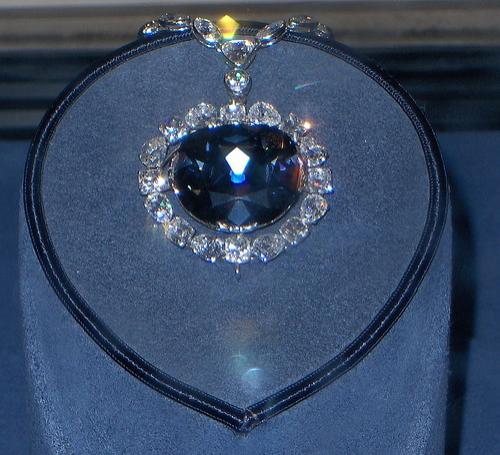 Submitted by LI - Executor on
Submitted by LI - Executor on

Diamonds, rubies, sapphires and emeralds - BLING-BLING! Let's take a virtual walk through history for a look at some of the most outstanding gemstones ever found. Most of stones have their very own notorious history and have become rather legendary.
As the old song alludes, “Diamonds are a girl’s best friend”, and while this may be true diamonds have also proven to be some of the most sought after gems in history. A diamond is a natural amplifier of energy and is one of the few stones that never needs recharging. It increases the energy of whatever it comes into contact. It is believed to carry the pure white light of the Universe and for this reason it can be rather merciless at times because it throws the absolute light of truth on anything thing that is negative leaving no choice except for transformation and transmutation. Diamonds are high vibe stones which energize all the chakras and fill holes in the aura while blocking geopathic and electromagnetic stress. Toady, diamonds are recognized as tokens of fidelity and commitment bringing clarity to partnerships… as they say “diamonds are forever!”
One of the most famous or infamous historical diamond is the Hope Diamond. According the legend, this deep steel blue diamond once served as an eye in a statue of the Hindu goddess Sita. The stone was stolen by a Brahman priest and immediately the angry goddess decreed that bad luck would befall anyone who thereafter wore her eye as jewelry. The original stone weighed in at 112 carats but later it was purchased by French King Louis XIV who had it cut into the 67.5 carat tear drop shaped stone. Louis refrained from wearing it after donning it only one time after which he contracted a fatal case of smallpox. His successor King Louis XV and his queen Marie Antoinette both used the newly named “French Blue” and everyone knows of their fate. After the French Revolution, the stone disappeared for 38 years resurfacing in 1830 on the London Market where it had once again been recut into the 44.5 carat gem that is recognized today. It was then purchased by Henry Thomas Hope, a British banker for $90,000 and to this day is known as the Hope Diamond. Hope suffered no notable misfortune connected to the stone but those family members who inherited it did. The stone changed hands several more times - a Greek gem dealer, a Turkish sultan, and gold heiress Evelyn Walsh Mclean, all who met with great misfortune and in some cases death. Finally the stone was purchased by New York jeweler Harry Winston who donated it to the Smithsonian Institution where it is still housed today in the Museum of Natural History.

The largest cut diamond in the world is the Cullinan I or the Star of Africa Diamond. It is the largest of the jewels cut from the original Cullinan Diamond that originally weighed in at 3,106 carats when it was unearthed in 1905 in the then two year old Premiere Mine near Pretoria. The diamond was named for Sir Thomas Cullinan who was the mine’s chairman.
The stone was sold for ₤150,000 by the government of Transvaal who in turn presented it to King Edward VII of Great Britain on his 66th birthday in 1907. The original Cullinan Diamond was cut into nine large stones and 96 smaller stones and 9.5 carats total weight of various fragments. The nine large stones remain in possession of the British Crown. The pear shaped 530.2 carat Cullinan I or Star of Africa stone is mounted in the British Royal Scepter.

The Mogul Emerald weighs in at 217.8 carats. It is embellished with an Islamic prayer written in Arabic script. The Mogul was mined in Columbia and was engraved by the late 17th Century Mogul rulers of India. It is believed to have possibly been worn as the centerpiece of a turban pin.
To this day, Emerald is a highly sought after gem and seeking it can be dangerous. In the areas of the world where the gem is found (particularly Columbia) those who seek it or mine it consider their treasure hunting profession at the very least “predatory” due to illicit forays into the mines, theft and even murder.
Emerald is actually a form of Beryl. Crystal healers associate the “vibe” properties of Emerald and Beryl to be connected to the Heart Chakra. The Emerald acts as a powerful influence in aiding in the recovery of infectious illness.

It has a particularly beautiful Sacred Geometry pattern connected to it that has been captured in this image by X-ray diffraction photography. Emerald has a hexagonal cell structure and when the atoms within the structure are exposes to the X-ray the rays are deflected by the atoms producing beams that radiate out in six directions producing the geometry. Rubies and Sapphires also have a hexagonal structure but differ according to the number, kinds and ratios of atoms within.
The Moguk Ruby also known as the Alan Caplan Ruby is one of the largest in the world weighing in at 15.97 carats. It sold for $3,630,000.00 in 1988 by Sotheby’s of New York. It was purchased by Graff of London who in turn sold it to the Sultan of Brunei.

Ruby is a stone of courage which stimulates positivity. It is also a great protector of the Heart Chakra. It is best worn on the finger, near the heart, or on the ankle.
Star rubies are very sought after gemstones. The asterism or “star” is a light reflection produced by many tiny needles that are oriented along the horizontal directions of the gem’s internal structure. All stones with asterisms open intuition.
The largest blue Sapphire in the world is believed to be the Logan Sapphire. This gem originated from Sri Lanka and weighs 423 carats. The gem has a “table cut” which was chosen to show off the gem’s beautiful blue coloring rather then its brilliance.

Sapphire colors are blue, yellow, green, pink, black and purple. Each differently colored gem has its own metaphysical properties – blue for spiritual truth, yellow for wealth, green for vision, pink for emotional clearing, black for centering, and purple for meditation and kundalini stimulation.
- 3590 reads